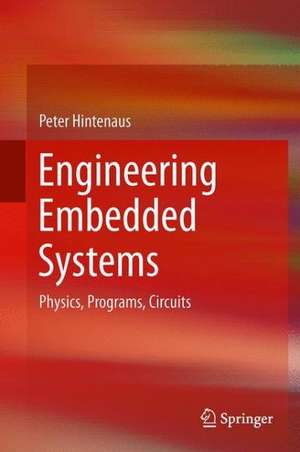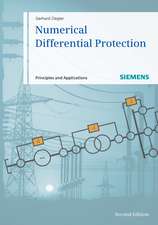Engineering Embedded Systems: Physics, Programs, Circuits
Autor Peter Hintenausen Limba Engleză Hardback – 11 noi 2014
Emphasis is placed on the physical nature of the problem domain and of the devices used. The reader is assumed to be familiar on a theoretical level with mathematical tools like ordinary differential equation and Fourier transforms. In this book these tools will be put to practical use.
Engineering Embedded Systems begins by addressing basic material on signals and systems, before introducing to electronics. Treatment of digital electronics accentuating synchronous circuits and including high-speed effects proceeds to micro-controllers, digital signal processors and programmable logic. Peripheral units and decentralized networks are given due weight. The properties of analog circuits and devices like filters and data converters are covered to the extent desirable by a systems architect. The handling of individual elements concludes with power supplies including regulators and converters.
The final section of the text is composed of four case studies:
• electric-drive control, permanent magnet synchronous motors in particular;
• lock-in amplification with measurement circuits for weight and torque, and moisture;
• design of a simple continuous wave radar that can be operated to measure speed and distance; and
• design of a Fourier transform infrared spectrometer for process applications.
End-of-chapter exercises will assist the student to assimilate the tutorial material and these are supplemented by a downloadable solutions manual for instructors. The “pen-and-paper” problems are further augmented with laboratory activities. In addition to its student market, Engineering Embedded Systems will assist industrial practitioners working in systems architecture and the design of electronic measurement systems to keep up to date with developments in embedded systems through self study.
| Toate formatele și edițiile | Preț | Express |
|---|---|---|
| Paperback (1) | 368.32 lei 38-44 zile | |
| Springer International Publishing – 22 sep 2016 | 368.32 lei 38-44 zile | |
| Hardback (1) | 399.67 lei 6-8 săpt. | |
| Springer International Publishing – 11 noi 2014 | 399.67 lei 6-8 săpt. |
Preț: 399.67 lei
Nou
Puncte Express: 600
Preț estimativ în valută:
76.49€ • 79.56$ • 63.14£
76.49€ • 79.56$ • 63.14£
Carte tipărită la comandă
Livrare economică 15-29 aprilie
Preluare comenzi: 021 569.72.76
Specificații
ISBN-13: 9783319106793
ISBN-10: 3319106791
Pagini: 345
Ilustrații: XXI, 345 p. 307 illus., 83 illus. in color.
Dimensiuni: 155 x 235 x 20 mm
Greutate: 0.69 kg
Ediția:2015
Editura: Springer International Publishing
Colecția Springer
Locul publicării:Cham, Switzerland
ISBN-10: 3319106791
Pagini: 345
Ilustrații: XXI, 345 p. 307 illus., 83 illus. in color.
Dimensiuni: 155 x 235 x 20 mm
Greutate: 0.69 kg
Ediția:2015
Editura: Springer International Publishing
Colecția Springer
Locul publicării:Cham, Switzerland
Public țintă
GraduateCuprins
Models and Experiments.- Tools - Mainly Mathematics.- Voltage, Current, Basic Components.- Digital Electronics.- Programmable Devices - Software and Hardware.- Analog Circuits - Signal Conditioning and Conversion.- Energy Conversion - Power Supplies.- Energy Conversion - Motor Control.- Data Recovery from Noise - Lock-In Detection.- Short-Range Radar.- Infrared Spectrometry.- Appendices.
Notă biografică
Dr. Hintenaus received a PhD in Computer Science from the University of Linz. He joined Kent State University in Ohio to work in Symbolic Computing. While being self-employed he designed a software package for computing the tool paths for milling pockets based on Voronoi diagrams. After a year as systems analyst in the pharmaceutical industry he joined FH-Joanneum. There he designed about 20 embedded systems, both hardware and software. The systems range from motor drives to ECG monitors, to CAN based field-bus communication, and to bridge-monitoring systems.
He has become the principal designer of the electronics and software of a Fourier transform infrared spectrometer. This instrument, marketed by the startup company i-red, has been installed at about 20 customer sites.
An optical moisture sensor of his design has been delivered to lead customers. Currently he teaches Computer Science at the University of Salzburg. His main research interests are Instrumentation and Measurement, Optical measurement systems and embedded and cyber-physical systems in general.
He has become the principal designer of the electronics and software of a Fourier transform infrared spectrometer. This instrument, marketed by the startup company i-red, has been installed at about 20 customer sites.
An optical moisture sensor of his design has been delivered to lead customers. Currently he teaches Computer Science at the University of Salzburg. His main research interests are Instrumentation and Measurement, Optical measurement systems and embedded and cyber-physical systems in general.
Textul de pe ultima copertă
This is a textbook for graduate and final-year-undergraduate computer-science and electrical-engineering students interested in the hardware and software aspects of embedded and cyberphysical systems design. It is comprehensive and self-contained, covering everything from the basics to case-study implementation.
Emphasis is placed on the physical nature of the problem domain and of the devices used. The reader is assumed to be familiar on a theoretical level with mathematical tools like ordinary differential equation and Fourier transforms. In this book these tools will be put to practical use.
Engineering Embedded Systems begins by addressing basic material on signals and systems, before introducing to electronics. Treatment of digital electronics accentuating synchronous circuits and including high-speed effects proceeds to micro-controllers, digital signal processors and programmable logic. Peripheral units and decentralized networks are given due weight. The properties of analog circuits and devices like filters and data converters are covered to the extent desirable by a systems architect. The handling of individual elements concludes with power supplies including regulators and converters.
The final section of the text is composed of four case studies:
• electric-drive control, permanent magnet synchronous motors in particular;
• lock-in amplification with measurement circuits for weight and torque, and moisture;
• design of a simple continuous wave radar that can be operated to measure speed and distance; and
• design of a Fourier transform infrared spectrometer for process applications.
End-of-chapter exercises will assist the student to assimilate the tutorial material and these are supplemented by a downloadable solutions manual for instructors. The “pen-and-paper” problems are further augmented with laboratory activities. In addition to its student market, Engineering Embedded Systems will assist industrial practitioners working in systems architecture and the design of electronic measurement systems to keep up to date with developments in embedded systems through self study.
Emphasis is placed on the physical nature of the problem domain and of the devices used. The reader is assumed to be familiar on a theoretical level with mathematical tools like ordinary differential equation and Fourier transforms. In this book these tools will be put to practical use.
Engineering Embedded Systems begins by addressing basic material on signals and systems, before introducing to electronics. Treatment of digital electronics accentuating synchronous circuits and including high-speed effects proceeds to micro-controllers, digital signal processors and programmable logic. Peripheral units and decentralized networks are given due weight. The properties of analog circuits and devices like filters and data converters are covered to the extent desirable by a systems architect. The handling of individual elements concludes with power supplies including regulators and converters.
The final section of the text is composed of four case studies:
• electric-drive control, permanent magnet synchronous motors in particular;
• lock-in amplification with measurement circuits for weight and torque, and moisture;
• design of a simple continuous wave radar that can be operated to measure speed and distance; and
• design of a Fourier transform infrared spectrometer for process applications.
End-of-chapter exercises will assist the student to assimilate the tutorial material and these are supplemented by a downloadable solutions manual for instructors. The “pen-and-paper” problems are further augmented with laboratory activities. In addition to its student market, Engineering Embedded Systems will assist industrial practitioners working in systems architecture and the design of electronic measurement systems to keep up to date with developments in embedded systems through self study.
Caracteristici
Four case studies describing concrete systems lead the student through successful design processes Gives computer science students enough physics to allow them to work with cyber-physical systems Working circuits throughout the book further the student's appreciation of the importance of analog and digital peripheral circuits End-of-chapter exercises ensure that students have assimilated learning objectives for each chapter Emphasizes the interdependence of design decisions concerning hardware and software Two non-trivial practical examples, radar and infrared spectrometry, for the use of Fourier-transform-based methods Includes supplementary material: sn.pub/extras















